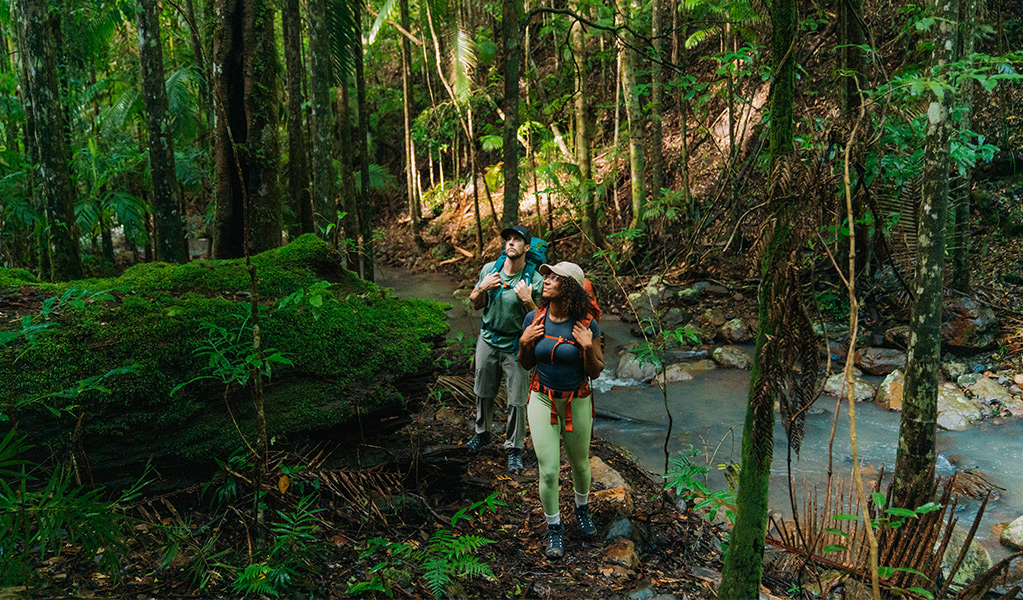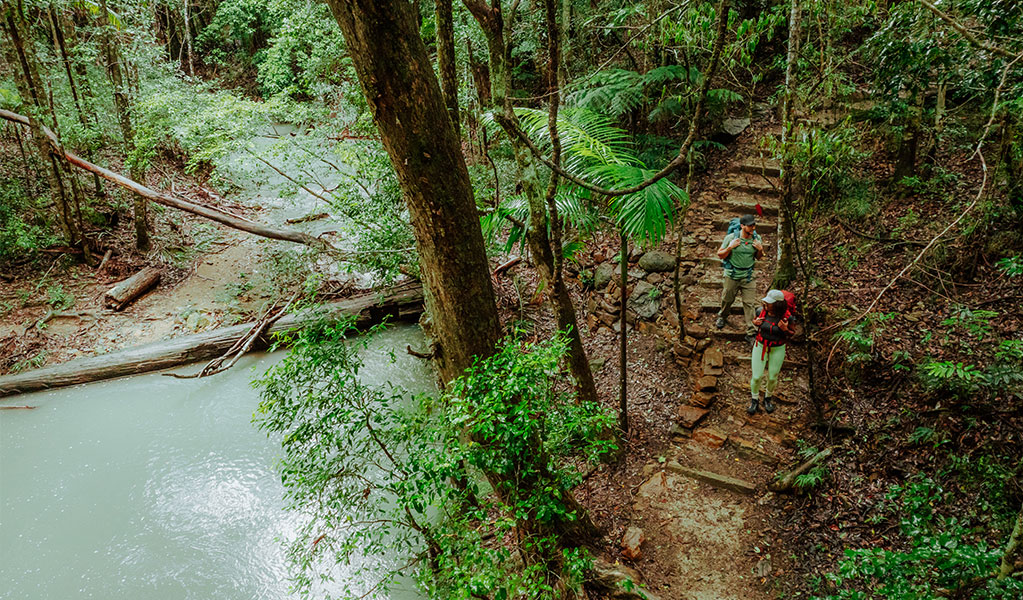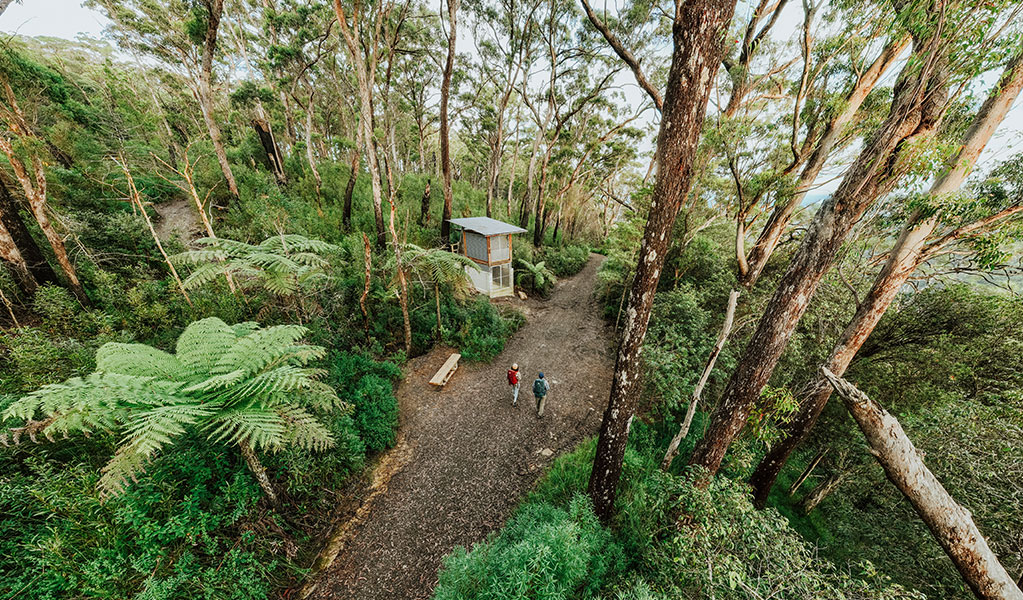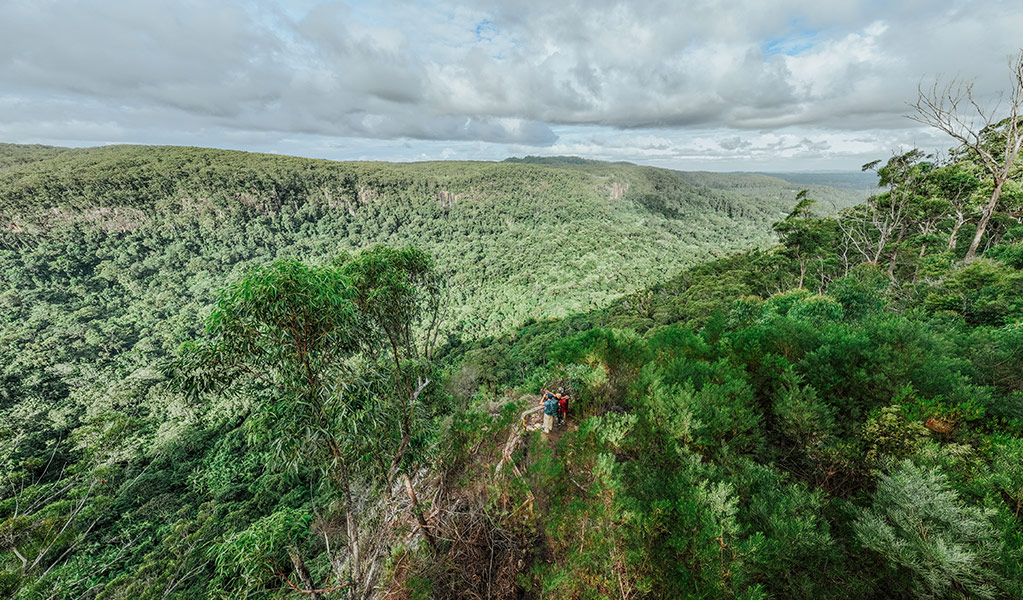Gidjuum Gulganyi Walk
North Coast
Overview
Over 4 days, hike through towering rainforest, clear mountain streams and ancient volcanic landscapes along Gidjuum Gulganyi Walk in the Tweed Byron Hinterland. Camp beneath the forest canopy on hardwood tent platforms.
- Where
- Whian Whian State Conservation Area, Nightcap National Park, Mount Jerusalem National Park in North Coast
- Accessibility
- No wheelchair access
- Distance
- 42km one-way
- Time suggested
- 4 days
- Grade
- Grade 4
- Trip Intention Form
-
It's a good idea to let someone know where you're going. Fill in a trip intention form to send important details about your trip to your emergency contact.
- Price
- From $173 for up to 2 people excluding transfers. Book your experience.
- What to
bring - Camping equipment, dry bag, cooking water, drinking water, food supplies, clothes for all weather conditions, first aid kit, personal locator beacon, gps, insect repellent, sunscreen
- Please note
- Make sure you have containers to carry at least 5L of water. Water is available to fill up at all 3 campgrounds but it's tank water so you must treat it before drinking.
- Always boil water for at least 5mins before drinking or use treatment tablets, a filter or UV treatment.
- You need to be fit and prepared for long, sometimes challenging hikes over 4 days, walking 4 to 9 hours daily with all your camping gear.
- The track features steep sections, many steps, and an elevation gain of about 600m on day 2, reaching 800m. Due to the terrain and length of this walk, you may encounter treefall across the track that requires you to deviate off-track temporarily.
- This subtropical climate can be very humid, with creek crossings that may become slippery or deeper during rainfall.
- Bring guy ropes to attach your tent to the hardwood tent platforms.
You need to book this 4-day walk. Camp at 3 secluded walk-in campgrounds along the way.
Detailed itinerary
Day 1: Manns Road track head to Sand Ridge campground
Distance: 8.5km
Time suggested: 2 to 4 hours
Toilets at: Manns Road track head, Sand Ridge campground
Water at: Sand Ridge campground
Your multi-day walk begins today, leading you into a landscape of diverse forests and tracks that will challenge and excite. Stop by Mullumbimby or Uki for last minute supplies before arriving at Manns Road track head – the last spot with reliable phone coverage until the start of day 2.
Ensure you have at least 3L of water per person for today’s walk and pack a reliable method to treat water for the days ahead. Start your walk at the Manns Road track head, following undulating paths through tall eucalypt forest and subtropical rainforest. Notice the striking contrasts in bark textures – from the rugged grooves of ironbark to the smooth, mottled grey of coachwoods.
Soon after you set out, a 3km return side track offers a chance to visit Unicorn Falls, a peaceful spot where moss-covered rocks frame a quaint waterfall. Continuing along the main track, the ridgeline leads to Whiskey Creek walk. Descending into the lush gully of Whisky Creek, you’ll be greeted by the refreshing sight of clear running waters with a vibrant green canopy overhead. This section includes 7 creek crossings – be mindful of slippery rocks and changing water levels after rain.
Take a moment at one of the creek crossings for a quiet morning tea and watch for the splash of an eastern water dragon. Continue on through eucalypt forest and subtropical rainforest and listen for the calls of the forest’s rare birdlife, including regent bowerbirds, paradise riflebirds and green catbirds. Crossing the creek a final time, you’ll follow an old logging track as it winds through towering palms and giant strangler figs on a gradual climb to the top of Middle Ridge. A little further on you'll descend off the ridge and eventually cross Sand Ridge bridge. A few hundred metres on, the track diverts off the management trail and leads you through creek lines framed by riparian rainforest.
The final ascent brings you to Sand Ridge campground, perched on a lower saddle of the ridge. Here, beneath the canopy of ancient New England blackbutt eucalypt forest, you can rest and reflect on your journey. An early night is recommended – tomorrow’s track will push your endurance with steep climbs but you’ll be rewarded with spectacular views.
Day 2: Sand Ridge campground to Yelgun Kyoomgun campground
Distance: 16km
Time suggested: 7 to 9 hours
Toilets at: Sand Ridge campground, Yelgun Kyoomgun campground
Water at: Sand Ridge campground, Yelgun Kyoomgun campground
Today’s walk is the longest and most challenging, offering sweeping views and a journey through eucalypt woodland and both warm temperate and subtropical rainforest. Prepare for uphill sections, numerous steps and 2 particularly steep sections that will test your stamina. Make sure you check your water supply before setting out, there are no refill points until Yelgun Kyoomgun campground.
Set out from Sand Ridge campground as early as possible, heading past the sheltered picnic table to the marked track at the southern end of the campsite. The walk begins with a steady 2hr climb through eucalypt forest and subtropical rainforest. Along the way, Grasstree lookout rewards you with magnificent views over the Tweed Caldera, with Wollumbin rising in the distance. The path you follow traces the ancient routes of Widjabul Wia-bal ancestors, who walked these lands many years ago while travelling through Country.
As the track winds south of Mount Jerusalem, the rainforest transitions into warm temperate rainforest before opening into eucalypt woodland. Look for lace monitors basking on sunlit tree trunks or moving stealthily through the undergrowth. Be cautious of slippery conditions after rain, particularly on the old Jerusalem Mountain Road. Soon you will arrive at Tweed Valley lookout, where views stretch across Commissioners Creek Valley. Back on the main track, you’ll descend into warm temperate rainforest. A 242m side track (one-way) offers a steep scramble to Jerusalem Cliffs, where dramatic views over Doon Doon await. From this rocky vantage point, look out for Doughboy Mountain and the Pinnacle in Border Ranges National Park. If you’re lucky, you might catch sight of a goshawk or other birds of prey soaring overhead.
Crossing the Doon Doon saddle marks your departure from Mount Jerusalem National Park. This section of the track passes through a private property easement, so please respect the landholders by staying on the marked track and avoiding unnecessary stops.
Soon after crossing into Nightcap National Park you will encounter Byron View lookout. On a clear day you can spot Byron Headland through a miraculous gap between surrounding landforms. The landscape here feels ancient and otherworldly, with dense rainforest and towering trees. Listen for the ‘chip chip’ call of the threatened rufous scrub-bird and watch for flashes of colour from fruit-eating rainforest doves.
The final climb takes you past Doughboy Mountain View lookout, with a spectacular vista to the north over Mount Tarrawyra. After a short walk, you will reach Tea Tree lookout, where fragrant tea tree scrub lines the Historic Nightcap track. To the south of the lookout, you’ll spot Postman’s Tree, a towering burnt-out New England blackbutt that once provided shelter for travelling postmen.
Day 2 comes to an end through temperate rainforest as you approach Yelgun Kyoomgun campground. Yelgun Kyoomgun (yell-gun key-oom-gun) means ‘sun and stars’ to reflect the view from the campground. The camp is nestled in an understorey rich with native mint and Lepidosperma clipeicola, a rare clumping sedge that only occurs in moist eucalypt forests at higher altitudes associated with the Mount Warning shield volcano. If you’re here during spring, vibrant yellow guinea flowers and blue flax lilies will be in bloom, adding bursts of colour to the landscape.
As night falls, watch for mountain brushtail possums and yellow-bellied gliders emerging in the treetops. Unwind as you take in the distant lights of Lismore twinkling far below – a magical close to an unforgettable day on the track.
Day 3: Yelgun Kyoomgun campground to Weeun Weeun campground
Distance: 11.5km
Time suggested: 3 to 5 hours
Toilets at: Yelgun Kyoomgun campground, Weeun Weeun campground
Water at: Yelgun Kyoomgun campground, Weeun Weeun campground
Your walk today will start and end with striking views. As you set out, the route descends along a ridgeline of the Nightcap Range. You’ll journey through landscapes that shift between rainforest and eucalypt forest. Look for bursts of orange fungi peeking through mossy carpets along the forest floor. In the cooler months, the elusive Albert’s lyrebird may be seen scratching through the leaf litter in search of food. The track weaves through shaded rainforest, following the gentle, soft paths of long-dormant logging roads.
You will cross Peates Mountain Road and link up to Perlite Road and Fork Fire Road before reaching the Eastern Fire Break. Midway along Fork Fire Road look out for the cascades which lead you off the track to a secluded creek, perfect for a cool down. Keep an eye on trail markers to stay on track, and take care crossing roads, as management vehicles may be present. Along the way, you might spot red-legged pademelons darting through the undergrowth.
As you approach Weeun Weeun campground, the landscape opens dramatically at Wanganui Gorge lookout. Sweeping views stretch across Coopers Creek and into Goonengerry National Park, framed by cascading waterfalls tumbling through cliffs and trees. Arriving at Weeun Weeun campground, you’ll find yourself perched on the edge of Wanganui Gorge overlooking Goonengerry National Park. Weeun Weeun (wee-ahn wee-ahn) means ‘home of the cleverman’ in the language of the local Widjabul Wia-bal People.
The lookouts within the campground precinct offer unique perspectives of the Wanganui Valley, where dense rainforest clings to steep slopes featuring waterfalls. As you savour the view, take care to stay well back from the lookout barrier.
At night, go spotlighting to find vulnerable animals like the yellow-bellied glider and marbled frogmouth. Set your torch to a red light to avoid damaging their eyes. Settle in for your final night on the track beneath the towering blackbutt trees. Let the calls of cockatoos and eucalyptus-scented air set the tone for reflection on the incredible journey so far. Rest up – tomorrow’s grand finale at Minyon Falls awaits.
Day 4: Weeun Weeun campground to Minyon Falls lookout
Distance: 6km
Time suggested: 2 to 3 hours
Toilets at: Weeun Weeun campground, Minyon Falls lookout
Water at: Weeun Weeun campground, Minyon Falls lookout
Day 4 begins with a clifftop path offering sweeping views of Wanganui Gorge and Coopers Creek. The track winds through rainforest and eucalypt forest, crossing creeks on the way to your final destination at Minyon Falls lookout.
The track takes you across creek crossings and wet areas on narrow boardwalks and stepping stones, surrounded by lush subtropical rainforest.
Filtered glimpses of the distant coast and Snows Gully Nature Reserve peek through the trees. Take extra care here, wet conditions can make the track slippery and the crossing can become impassable after or during heavy rainfall.
As you approach Rummery Park campground, you’ll discover a rustic timber walkway (tread carefully on the beams). Arriving at the campground, you’ll be greeted by resting kookaburras perched among the tall Hoop pines.
From here, follow Boggy Creek walk for about 45mins, tracing the clear waters of the creek. The track winds through gullies framed by towering blackbutt and turpentine trees, with short, steep climbs leading to tranquil resting spots beside the creek. As you near Minyon Falls, the crashing roar of the waterfall will guide you to the spectacular lookout. From the lookout platform, pause to take in the view of the deep palm-shaded gorge roughly 100m below – a fitting end to your 4-day adventure. On a clear day, the view stretches all the way to the coast.
If you’re still eager to explore, several short walking tracks await in the Minyon Falls area. Nearby Rummery Park campground provides a peaceful option for those wishing to stay longer. The view from Minyon Falls lookout is the best in the area.
Minyon Falls picnic area has plenty of shady trees and picnic tables to enjoy a snack. If you booked transfers with Vision Walks Eco Tours, meet them at the carpark for your return transfer.
Local alerts
For the latest updates on fires, closures and other alerts in this area, see https://www.nationalparks.nsw.gov.au/things-to-do/walking-tracks/gidjuum-gulganyi-walk-app/local-alerts
Bookings
- National Parks Contact Centre
- 7am to 7pm daily
- 1300 072 757 (13000 PARKS) for the cost of a local call within Australia excluding mobiles
- parks.info@environment.nsw.gov.au
Park info
- in Whian Whian State Conservation Area in the North Coast region
Whian Whian State Conservation Area is always open but may have to close at times due to poor weather.
- in Mount Jerusalem National Park in the North Coast region
Mount Jerusalem National Park is always open but may have to close at times due to poor weather or fire danger.
- in Nightcap National Park in the North Coast region
Nightcap National Park is always open but may have to close at times due to poor weather, fire danger or management operations.
Visitor info
All the practical information you need to know about Gidjuum Gulganyi Walk.
Track grading
Features of this track
Distance
42km one-way
Time
4 days
Quality of markings
Sign posted
Experience required
Experienced bushwalkers
Gradient
Very steep
Steps
Many steps
Quality of path
Rough track, many obstacles
Getting there and parking
Gidjuum Gulganyi Walk starts in Mount Jerusalem National Park and ends in Nightcap National Park. You need to have a booking to do this walk.
If you choose not to book return transfers with Vision Walks Eco Tours, we strongly recommend you get dropped at Manns Road track head. We don't advise leaving your vehicle in this very remote location overnight. You will also need to arrange a pickup at Minyon Falls carpark at the end of the walk. The access roads may become impassable in wet weather, so plan accordingly.
From Mullumbimby, follow Main Arm Road to the end and then turn right onto Manns Road. After 2km, the Manns Road track head carpark will be on the right. From Uki, follow Manns Road for 3.5km and the carpark will be on the left. This is the same carpark used to access Unicorn Falls walking track.
Road quality
- Mixture of sealed and unsealed roads
Parking
There is a carpark at Manns Road track head and a carpark at Minyon Falls picnic area.
Facilities
The 3 hiker camps along this 4-day walk have:
- Non-flush toilets
- Rainwater tanks. You must treat water before drinking
- Picnic tables and shelters
- Yarning circles
- Hardwood tent platforms with tie down points for guy ropes
Toilets
- Non-flush toilets
Picnic tables
Carpark
Maps and downloads
Accessibility
Disability access level - no wheelchair access
Prohibited
Camp fires and solid fuel burners
Pets
Pets and domestic animals (other than certified assistance animals) are not permitted. Find out which regional parks allow dog walking and see the pets in parks policy for more information.
Smoking
NSW national parks are no smoking areas.
Learn more
Gidjuum Gulganyi Walk is in Whian Whian State Conservation Area. Here are just some of the reasons why this park is special:
4,000 years of Aboriginal culture

The conservation area is located within the traditional lands of the Widjabal clan of the Bundjalung Nation. Evidence from recorded sites suggests Aboriginal use of the Nightcap Range for at least the last 4,000 years. The area has intrinsic cultural values to the Widjabal People and the land has significant connections with other recorded sites in the adjacent Nightcap National Park.
- Byan Yangala loop walk Travel back in time as you walk through ancient Gondwana rainforest on the Byan Yangala loop walk. Immerse yourself in nature less than 1 hour from Byron Bay.
Historic heritage of timber-getters

Lured by the opportunity of employment in difficult times, timber-getters began logging in the Whian Whian area in the 1830s for red cedar, a particularly sought after timber. In 1871, surveyors identified a track over Nightcap Range to link Lismore with Murwillumbah. This allowed cedar-getters access to previously isolated expanses of forest. The Rummery Park campground was originally a forestry camp, and its use dates back to the 1930s. The inter-war period was the most active period for forestry use of the campground. Peates Mountain Road (now part of the Nightcap track) was built during the depression of the 1920s and 1930s. Sleeper-cutters who claimed timber unsuitable for milling, camped nearby on the other side of Boggy Creek at Rummery Park.
- Historic Nightcap walking track Historic Nightcap walking track leads through World Heritage-listed rainforest, offering scenic views across Nightcap National Park and Whian Whian State Conservation Area, near Byron Bay.
Plant life galore

An astounding 520 plant species have been recorded here – making it an incredibly diverse place when it comes to vegetation. There are 10 broad ecosystems, including subtropical and warm temperate rainforests and various types of wet sclerophyll forest.
- Boggy Creek walk Boggy Creek walk in Whian Whian State Conservation Area takes you through blackbutt forest and along the beautiful Boggy Creek to Minyon Falls. You can swim in the inviting pools along the creek.
- Historic Nightcap walking track Historic Nightcap walking track leads through World Heritage-listed rainforest, offering scenic views across Nightcap National Park and Whian Whian State Conservation Area, near Byron Bay.
Walk with the animals

There’s also an incredible variety of native animal species thriving in these rainforests – over 270 native species, around 50 of which are listed as threatened, including the spotted tailed quoll. Koalas and Albert’s lyrebird, with its distinctive calls and mimicking echoes, can often be heard through the forest in the cooler months.
- Byan Yangala loop walk Travel back in time as you walk through ancient Gondwana rainforest on the Byan Yangala loop walk. Immerse yourself in nature less than 1 hour from Byron Bay.
- Whian Whian mountain biking trails Suitable for bushwalkers, cyclists and horseriders, Whian Whian mountain biking trails near Byron Bay offer stunning views of waterfalls and rainforest.
World heritage worthy

The conservation area has similar vegetation and natural heritage values as those found in the adjoining Nightcap National Park, one of the 50 reserves in northeast NSW and southeast Queensland that make up World Heritage Central Eastern Rainforest Reserves Australia.
- Whian Whian mountain biking trails Suitable for bushwalkers, cyclists and horseriders, Whian Whian mountain biking trails near Byron Bay offer stunning views of waterfalls and rainforest.
Plants and animals protected in this park
Animals
-

Albert's lyrebird (Menura alberti)
The Albert’s lyrebird is much rarer than the superb lyrebird. Distinguished by its richer brown plumage and less elaborate tail feathers, it’s protected as a threatened species in NSW.
-

Koala (Phascolarctos cinereus)
One of the most renowned Australian animals, the tree-dwelling marsupial koala can be found in gum tree forests and woodlands across eastern NSW, Victoria and Queensland, as well as in isolated regions in South Australia. With a vice-like grip, this perhaps most iconic but endangered Australian animal lives in tall eucalypts within a home range of several hectares.
-

Common brushtail possum (Trichosurus vulpecula)
One of the most widespread of Australian tree-dwelling marsupials, the common brushtail possum is found across most of NSW in woodlands, rainforests and urban areas. With strong claws, a prehensile tail and opposable digits, these native Australian animals are well-adapted for life amongst the trees.
-

Kookaburra (Dacelo novaeguineae)
Of the 2 species of kookaburra found in Australia, the laughing kookaburra is the best-known and the largest of the native kingfishers. With its distinctive riotous call, the laughing kookaburra is commonly heard in open woodlands and forests throughout NSW national parks, making these ideal spots for bird watching.





